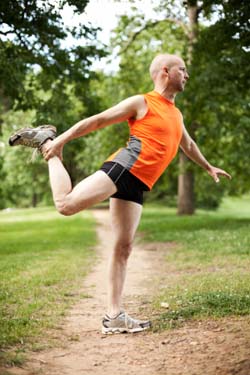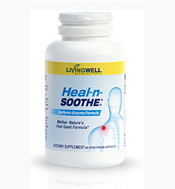Chances are if you went to public school, you went to gym class. And in gym class you learned that it was important to warm up before you exercise.
What your gym teacher didn’t know was that only some warm up exercises are good for you… and some, when performed incorrectly, can actually weaken your body or cause serious damage.
It’s time to have a close look at exactly when and how you should stretch… because the difference it makes can be huge.
The 5 Worst Ways to Stretch
1. Stretching Infrequently
While the jury is still out on exactly how beneficial stretching is, we know for sure that stretching improves flexibility and increases blood flow through the muscles. And increased flexibility definitely increases athletic performance, range of motion, and reduces your risk for injury.
Stretching infrequently means you won’t be get the benefits of increased performance and injury reduction.
Even though it’s time consuming, the best times to stretch are after you’ve cooled down from your exercise, and you should aim for 2-3 times per week minimum. Remember, if you don’t use it, you’ll lose it.
If you aren’t used to stretching or are very inflexible, you shouldn’t expect to jump right in to a master’s yoga class. Be gentle with your body and listen to it. Stretching isn’t always comfortable, but it shouldn’t be painful either.
2. Stretching to Warm Up
Contrary to popular belief, you should not stretch your quadriceps or your calves with toe touches before you run. Static stretching like this is excellent once you’ve cooled down from your workout – but it’s one of the worst things you can do to warm up.
“You may feel as if you’re able to stretch farther after holding a stretch for 30 seconds, so you think you’ve increased that muscle’s readiness,” says Malachy McHugh, director of research at the Nicholas institute of Sports Medicine. But, as McHugh explains, the muscle is so stretched out it’s actually weakened. It’s loose – and for exercise and sport, you want muscles to have a quick, tight reaction. Muscles can remain weakened up to 30 minutes after stretching, McHugh said.
Plus, stretching “cold” muscles can also cause serious damage. Imagine raw spaghetti compared with cooked. Raw spaghetti snaps at the touch, while cooked is more flexible and stretchy. Cold muscles are similar. Stretching a cold muscle can damage muscle fibers more quickly because they’re stiffened by a lack of hot, flowing blood and oxygen.
3. Stretching Incorrectly
“Stretching incorrectly can actually do more harm than good,” explains the Mayo Clinic, even if you’re warmed up. One wrong tweak is all it takes to do some serious damage.
Many stretching risks are a result of improper technique. Here are some of the stretches most commonly performed incorrectly – and how to do them safely:
- Seated Hamstring Stretch: Sit tall and extend your right leg out in front of you. Bend your left leg so your foot rests comfortably at your thigh or knee. Bend forward over your straight right leg. Bend from the hip, keep your back straight and do not fold over. Do not bend your right knee, as that negates the stretch. Repeat on the opposite side.
- Standing Quad Stretch: Stand tall with your hips square to the ground. Bend your right knee and bring your right ankle to either hand behind you. (The hand makes no difference as long as you keep your knee parallel to the ground.) Do not jut it out or twist your foot out. You should feel the stretch in your quad and hip flexor. If you feel it in your knee, you are pulling too hard on your foot.
- Standing Side Stretch: Stand with feet double your shoulder width. Keep your hips square. Raise one arm above your head, but do not raise your shoulder. If your right arm is raised then lean left so your side gets a good stretch, and vice versa. Keep your upper body within the same plane as your lower body. (Imagine you are in a toaster, and if you rotate forward or backward, you’ll be burned toast.) It is okay to support your upper body weight on the outside of the thigh, but not on your knee.
4. Stretching with a Bounce
Bouncing while stretching is almost as bad as stretching to warm up. Adding aggressive movements to your stretches makes you lose control of the stretch, potentially causing additional micro-tears in the muscle.
That doesn’t mean you are limited to static stretching. Dynamic stretching by adding gentle movement to your stretches through a range of motion can be beneficial.
5. Overstretching
One of the easiest ways to overstretch is to stretch cold. “There is a neuromuscular inhibitory reaction to static stretching,” explains McHugh. Just because the pain appears to decrease as your mental tolerance for the stretch increases doesn’t mean you’re doing good work.
If you’re sore the day after you stretch, that often means you’ve overstretched.
Reduce Stretching Risks With Post-Workout Routine
Your post-workout routine should always include stretching – no matter how little time you feel you have. Not only will stretching reduce your risk of injury, proper stretching will help you feel less sore the next day.
But, your post-workout routine shouldn’t end with stretching alone. Make sure you rehydrate with plenty of water. Enjoy a small, protein-based meal or protein shake (a 60% carb / 40% protein mix is great). Finally, help your muscles recover by taking a proteolytic enzyme supplement.
Proteolytic enzymes not only reduce painful post-workout inflammation, they eat up excess fibrin – the stuff scar tissue is made of that leaves your muscles stiff and sore long after your workout.
A natural proteolytic enzyme supplement helps your muscles stay loose and unrestricted long after your workout and stretching routine is finished. And that kind of flexibility, of course, is one of the big reasons to stretch in the first place.
Discover the Difference for Yourself!
Heal-n-Soothe® is the only natural pain reliever with high doses of proteolytic enzymes and 12 all-natural pain relievers. Discover the difference it makes for yourself by trying a FREE bottle today!
Yes! Send My FREE Bottle of Heal-n-Soothe®!
References
Stretching: Focus on flexibility. Mayo Clinic. Fitness: In-Depth. 2011 Feb. 23.
Reynolds G. Stretching: The Truth. The New York Times: Phys Ed. 2008 Oct. 31.




Can you please recommend some balance-exercises?
Thank you very much.
Shoshi
Hi Shoshi,
Thank you for your comment and question. A good starting point for you is to get yourself a copy of our back pain book The 7 Day Back Pain Cure which you can order via the link below. It has a lot of information to help you regarding the back, treatment options and pain relief plus many other useful aspects for you to read and consider. We do hope you find it helpful.
https://losethebackpain.com/products/7-day-back-pain-cure-book
Thank you
Admin (THBI)